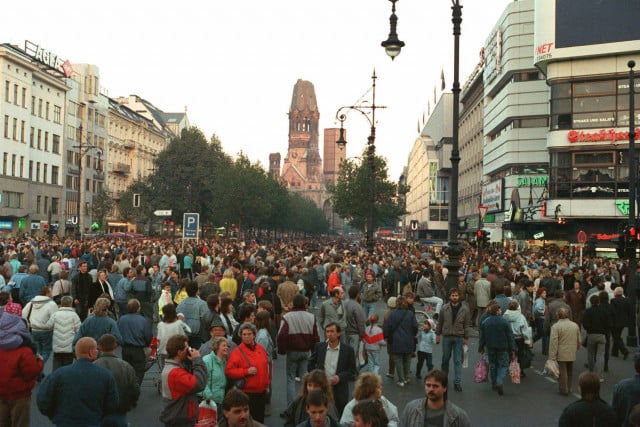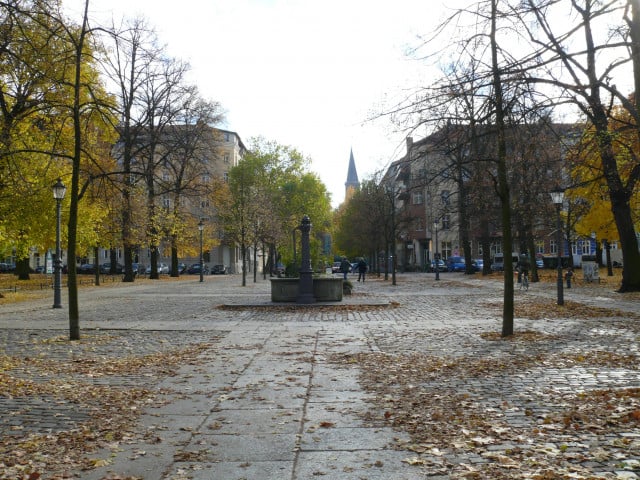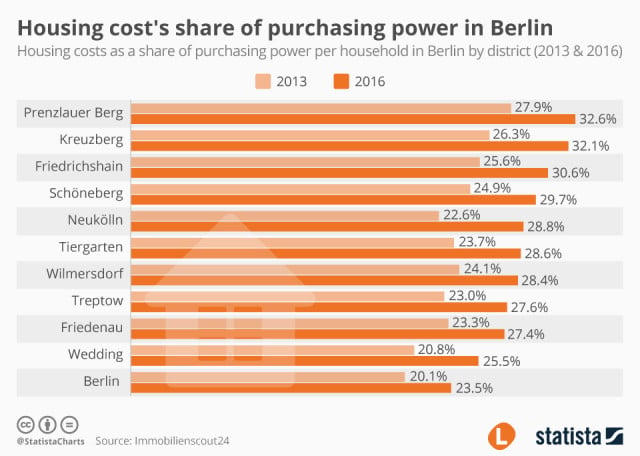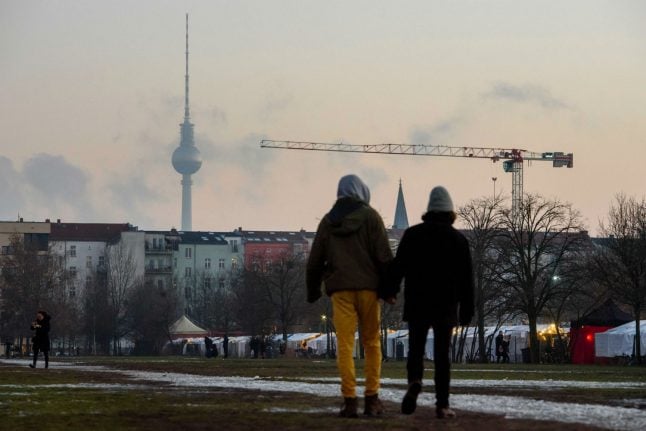“Alles” – or everything – was the most common response when we asked longtime Berliners what has changed over the past 30 years in the German capital.
They spoke of the increased diversity, a better standard of living, and the renovation of tattered post-war Altbau buildings – plus the construction of numerous Neubauten. But many also saw the downsides: skyrocketing rents, and greater concerns about safety and finding employment.
We made the following video in partnership with Easy German.
READ ALSO: Five things you need to know about the Berlin Wall
“Berlin has become more crowded, more colourful, more dangerous and louder,” a 60-year-old woman who lived her whole life in Prenzlauer Berg told us.
“Berlin is not at all what it was before 30 years ago,” said the Berlin-born owner of a café bordering Arkonaplatz, a large square with a playground designed for families with young children in the German Democratic Republic (GDR).
“Only 10 years ago this area was in very poor condition,” she said of the neighbourhood in central Mitte, part of the former East and now one of the most coveted and pricey in Berlin, as is the case with its neighbouring Prenzlauer Berg.
Especially over the past few years, she has grown accustomed to speaking English with the many customers from around the world on a daily basis.
“Richtige Berliner sieht man kaum noch,” she said with a laugh. You hardly see real Berliners anymore.
Where they were when the Berlin Wall fell
When asked what it was like to live in Berlin directly after the Mauerfall (fall of the Wall), one former East Berliner said that there was “Große Ungewissheit,” or great uncertainty.
She was simply neugierig (curious) the day following the monumental event. That night, she left her one-year-old child with her mother and ventured into Kreuzberg, the still-trendy Kiez, or neighbourhood, that had bordered the barrier, to celebrate in nightclubs with masses of other young people from both East and West.
Even if they were not in Berlin on November 9th, 1989, Germans told us they were glued to the TV news, many crying and waking up their children to tell them what was happening.
“It was very moving,” said a local resident, originally from Münster in western Germany, who watched the televised event.
Another woman, who lived in an apartment on Kurfürstendamm, former West Berlin’s largest shopping street, said that she could not enter her own flat for a few days. The city overflowed with former East Germans who poured in directly following the news.

Kurfürstendamm on November 11th, 1989. Photo: DPA
“It was total Wahnsinn (madness),” she said. “[Both East and West Germans] didn’t think that everything could happen so suddenly.”
While a misunderstanding at a press conference at around 7 pm was the event that famously led for border guards to open the gates, it was not until around 10:45 pm that all control points were opened.
So-called Ossis (Easterners) swarmed through the gates, and were met by Wessis (Westerners) who greeted them with flowers and champagne.
Yet a couple people said they were simply sleeping when the monumental events occurred, and in the morning woke up to a changed Berlin, and Germany.
‘I’m thrilled by all the diversity’: What were the positive changes?
“This was one of the most dead parts of Berlin,” said a resident of Berlin’s Bernauer Straße, gesturing down both directions of the street where the wall once ran, dividing East and West.
But now, he said with a smile, “all hell breaks loose” on Sundays at Mauerpark across the street, with Berliners and tourists from around the world descending on the famous flea market.
On August 13st, 1961, neighbours on both sides of Bernauer Strasse watched on as the border began to be constructed, slowly obliterating their view. Over the next 28 years, responding to several escape attempts, authorities made the wall wider and deadlier to cross.
Now, said the longtime resident, “I’m thrilled by all of the diversity, the openness, and the culture.”
Standing in front of a weekly international food market at Arkonaplatz, a long time Berliner from western Germany praised the “mixture of younger people from all over the world.”

Arkonaplatz in the former East Berlin neighbourhood of Mitte. Photo: DPA
A man who had just picked up his grandson from a nearby Spanish and German bilingual Kita also added that “nowadays it is so multicultural here. Almost every language in the world is here.”
When the Wall fell, he was in his native Erfurt, the capital of the eastern state of Thuringia, and a year later headed across the border.
Another former east German, 21-year-old when the wall fell, said the most important change was that, “Ich bin viel verreist,” she said smiling. “I traveled a lot.”
‘He had a different status in the East’: What were the negative changes?
While several residents praised the capital’s colourfulness – or the large number of foreigners who have flowed into Berlin since the fall of the wall – a lifetime east Berliner said that “ab und zu” (every now and again) they annoy her. “They are so loud,” she said. “The children around here never seem to sleep.”
She also felt that the onslaught of Berlin newcomers – also from other parts of Germany – led to too-high housing costs. Following the Mauerfall, she moved from her sprawling flat on Prenzlauer Allee into a more affordable apartment on Schwinemünder Strasse.
“I couldn’t pay for the nice Altbau in which I was living anymore,” said the woman, pointing out that “actually nothing” changed for the better.
“We had our apartment, our car, the children had their work,” she added. “We can’t say that we were starving. That wasn’t the case.”
In German, the term “Ostalgie” applies to former East Germans nostalgia for aspects of life in the GDR, be it the ideology or general stability.
“Everything became a little too orderly, a little too expensive,” said another east Berliner in her 20s about the years following November 9th, 1989.

The neighbourhood of Prenzlauer Berg, located in the former East, is now considered to be Berlin's most expensive.
After the Mauerfall, a lot of people were suddenly out of a job – or overqualified for the jobs available, said one lifelong Berlin resident in Mitte.
Her husband initially kept his job, but shortly afterwards he found himself out of work when his former company ceased to exist. Being over 50 years old and out of work, “it was very hard for him to find a job.”
“I went to work [as a dental assistant] but he was unable to find work,” she said. “He had a different status in the East.”
Do differences still remain?
The recent elections in the eastern states of Thuringia, Brandenburg and Saxony, in which the far-right Alternative for Germany (AfD) became the second most popular party, show that strong differences between east and west still remain, said a language teacher from Frankfurt who moved to Berlin shortly before the fall of the Wall.
READ ALSO: AfD surges to second place in Thuringia state elections
They received even more votes than German Chancellor Angela Merkel’s Christian Democrats (CDU), who “organized that Wiedervereinigung (reunification) back then.”
Almost one in five of the approximately 82.8 million people in Germany live in the former East, although the population has decreased by two million since the Wende – a ‘shift’ which refers to the fall of the Wall.
There still remain stark differences, with the east having higher unemployment and poverty, and lower wages that in the western part of the country. There are also more reported cases of far-right acts of violence.
READ ALSO: The East-West divide is diminishing, but differences remain
East Germans went nearly directly from dictatorship, National Socialism, to another, the GDR, said the teacher, who helps immigrants to Berlin learn German. “They never had a chance to learn democracy the way that we learned it in West Germany.”
“Many in East Germany don’t accept that it’s now better. They have the freedom of travel, a social state, and health insurance without end. They don’t understand that it’s now better for them, and complain about problems that don’t exist.
There is little doubt that, over the past 30 years, “East Berlin has become more open and more international,” said another longtime Berlin resident who came to the city following the Mauerfall.
He added: “I only wish that for the rest of the East now.”



 Please whitelist us to continue reading.
Please whitelist us to continue reading.
Member comments